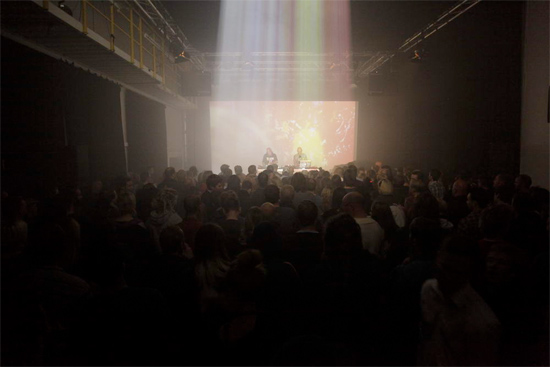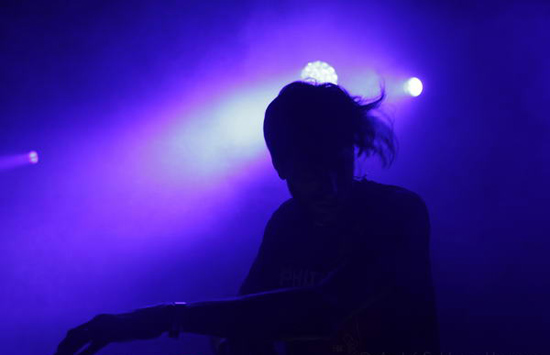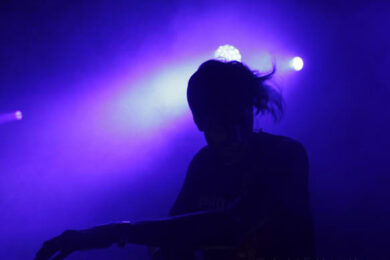Norway’s population is smaller than that of Greater London. Stavanger is its fourth largest city – after Oslo, Bergen and Trondheim – but with a population of 120,000, in the eyes of an adopted Londoner it seems to have scant claim to its ‘city’ status (aside from its small, beautifully austere cathedral). It’s on the edge of fjord territory, and as our plane drops through a bank of grey clouds to make its final approach I’m struck by the almost cartoonish precarity of its construction: buildings cling daintily to hilltops, nuzzle up against the water’s edge or else, out into the water, settle on a pointillist scattering of miniscule islands connected by sleek bridges and ponderous ferry routes. It’s an exotic mix: the supreme inefficiency of a parochial, age-old lifestyle, augmented with the wealth of one of the most developed countries in the world.
The city, crouched on a peninsula near Norway’s southwestern tip, has another name: The Oil Capital. Its status as a main base of operations for the North Sea oil industry makes it the most expensive city in the world’s third most expensive country, a place where a litre of weak-ish lager in a plastic cup will set you back seven pounds, and where a one-course restaurant meal of middling quality costs closer to 30. The oil industry, and the wealth it brings to the city, defines Stavanger. Before dinner on my first night there I head out to explore. The city centre is a creation of elegant density, its antiquated steep-roofed wooden houses arranged in complex folds, overlapping and interweaving across the precipitous landscape. Much like the extraordinary rock formations that this part of the world is renowned for, its architecture is orderly but bewilderingly complex – a single wrong turn can lead to total disorientation, even if you’re never more than five minutes from a familiar landmark. But to the city centre there is also – during the day at least – an air of rigorous gentrification: boutique fashion shops line pristine cobbled streets, fountains bubble away with placid grace, and immaculately dressed Norwegians go sedately about their business. Vigorous multicultural melting pot this is not.
I’m here to experience two distinct but intertwined events. The first is Nordic Music Week: a small, friendly conference for industry types which invites delegates from across Scandinavia and the rest of Europe to experience the cultural wares of the city and of Norway at large. The second is Numusic, a long-standing electronic music festival (Norway’s oldest in fact) that takes place across three nights in a venue slightly out of town. For the first night though, the evening meal dispatched with, we take the short walk to Stavanger Cathedral where Icelandic musician Olafur Arnalds is to open proceedings. His performance is predictably pleasant – although nothing Arvo Pärt didn’t do several decades earlier, and better. Fortunately the unfailing earnestness of his compositions, here bulked out with a couple of string players and a dusting of electronic beats, is counterbalanced by some excellently self-effacing banter, and by the beauty of the setting: an ascetic affair of white stone and dark wood, with bulbous, spiked chandeliers hanging over the nave like fruit trees of some severe Nordic variety.
The following day the festival program begins in earnest, presenting us with the first opportunity to experience the venue where we will spend most of our time, and one whose history is inextricable from that of the Numusic festival: Tou Scene. The red-bricked building, sitting by the water on the edge of the Storhaug neighbourhood a short walk from the city centre, housed a brewery for almost a century before it closed down in the 80s. The following decade, the creatives moved in – including Leeds-born DJ and visual artist Martyn Reed – and the painstaking regeneration process began. Reed launched the Numusic festival in 2000, aiming to promote local talent alongside international names and adopting the ethos "from Stockhausen to techno" (past bookings have lived up to this, quite literally). He has since expanded the operation to include Nuart, an event celebrating Stavanger’s surprisingly lively street art scene – evidence of which subtly permeates the walls and crevices of the city. Tou Scene, meanwhile, is now a marvelous three-roomed, 600 capacity venue whose decor walks the line between post-industrial decrepitude and bohemian exorbitance; the kind of site of which London clubbers dream when they read "secret warehouse location" on a drizzle-soaked flyer.
Upon entering the venue, though, it’s difficult not to notice the thrum of a building site just a few hundred yards away, where a handful of apartment blocks are being thrown up with the familiar haste of real estate developers with their eye on the bottom line. When I ask later on whether the new buildings represent a threat to Tou Scene – noise complaints, that sort of thing – the answer is an unequivocal yes. So it is that the wheels of gentrification grind on.

I am not, however, here simply to look at the architecture. Having tentatively explored the venue, I’m due to speak on a panel under the heading "Elements of a music scene", alongside a mixture of visiting academics and local scene figureheads. It quickly becomes apparent, though, that the discussion is animated by an underlying and more heartfelt question: why is the music scene in Stavanger so anaemic – and what is required to make it truly healthy? Stavanger, it emerges, is a city with an inferiority complex, keenly aware that it lacks the vibrant bohemianism of Bergen, several hours’ drive up the coast, and the cosmopolitan bustle of Oslo over the mountains to the east. Nordic Music Week, set up during Stavanger’s tenure as European capital of culture in 2008 as the city’s answer to the by:Larm festival, emerged from an attempt to redress that balance.
The past four years have seen vast quantities of money pumped into the city’s cultural sector – even by the standards of a Social Democratic country whose creative life is stimulated at every level by the public purse. Still, the overall mood seems to be one of dissatisfaction, and there’s a pervasive sense that the lavish investments of recent years have produced only the outward appearance of cultural vibrancy in a city stifled by oil-derived affluence. The latest grand gesture of cultural improvement is the newly opened, several thousand capacity concert house, situated on the harbour’s edge within a few hundred metres of its (still functioning) predecessor. I hear it suggested that this is a neat symbol of where the city’s allegiance truly lies: not with its grassroots creative community, but with the wealthy oil elite for whom "high-brow" culture is a trophy of success. As if to confirm the suspicion, a gleaming new BMW was given pride of place in the concert house foyer during its opening week, perhaps the grand prize in some shopping mall-esque raffle.
Still, there’s no denying that the beneficence of the state plays a central role in the week’s successes. Both festivals rely heavily on public funding and, if they can collectively be seen as a riposte to the city’s detractors, then they are a very fine one. The following few days are a blur of talks, workshops and performances, which see us criss-crossing the grey, rain-soaked city centre to visit an array of small venues. At one point we venture out of town to the local NRK studio for an inspiring workshop from New York producer Joel Hamilton; the previous day we take a boat down the nearby Lysefjord, hemmed in by gorgeous vertiginous rock faces on either side, to see Pulpit Rock – an uncannily smooth altar-like outcropping which is a favoured destination for tourists (and, I’m told, a European suicide hotspot). Throughout, the impression given is of a small and intimate local scene which – while it may face indifference from Stavanger’s wider community – is nonetheless more fully formed and active than that of any city of similar size in the UK.
Counterbalancing the more sedentary daytime activities is Numusic’s evening program, which improves incrementally each day. The Thursday night is dominated by Kompakt-signed Icelandic quartet GusGus who, as their euphoric slow-burners suggest, have been around for long enough to have caught the trance bug when it was still lurking in the underground. The two singers seem to embody the group’s cultural schizophrenia: one gradually strips off his Sunn O)))-esque robe as the set progresses to reveal a rugged viking physique; the other remains fully clothed, neatly turned-out in the Kraftwerk style. The crowd, seemingly mostly composed of locals, are a somewhat reserved bunch – full-on, pill-munching rave this ain’t – but friendliness and positivity predominates, and by closing time those that remain have been coaxed fully out of their shells.

The following night, Emika cuts an icily glamourous figure as she turns in a fine set of dank Berghain ballads – a sound which works marvellously in the rusted surrounds. We then head upstairs for Hanne Kolstø, a singer based just down the coast in Kristiansand, whose rich synthetic arrangements and pungent vocals seem to occupy a distinctly Norwegian soundworld. Mad Professor, though, is the highlight: his live dub set sticks to roots favourites for the most part, but his deftness on the mixing desk is a delight to behold; at one point the overwhelming sheets of sound manage to dislodge a cloud of plaster from the ceiling onto the dancing heads and shoulders below.
Saturday sees the venue at its busiest. Former Lindstrøm collaborator Christabelle is our first port of call, presenting her compellingly weird new live set which, with its angular backing and supporting beatboxers, recalls Medulla-era Bjork. This is a sparser, sweatier affair though, climaxing with a surreal rehashing of Joe’s UK anthem ‘Claptrap’. London duo Raime are far less kinetic but all the more extraordinary for it, summoning a slow-motion tidal wave of gothic dread. Norwegian duo Next Life, meanwhile, offer a 20 minute refresher of blistering chiptune speed metal; a rare showing for Norway’s strong metal tradition in a bill mainly focused on the electronic.
But the festival’s undisputed highlight is saved for its close. Lindstrøm himself – a Stavanger boy done good – returns from his base in Oslo to deliver an hour of his trademark cosmic disco in Tou Scene’s crowning glory, the Machine Room. Perhaps responding to the space – a compact ground floor bunker with its industrial accoutrements (arcane machinery, battered piping) still intact – Hans-Peter keeps things appropriately dancefloor-focused, his kickdrums throbbing through the hefty sound system with ecstatic force and clarity. After a jubilant encore, all that’s left is to spill out into the night and make our way back to our hotel through the light autumnal drizzle.
The following day, busily emptying my pockets at the airport on my way through security, I spot Lindstrøm doing similar, his two young sons in tow. It strikes me that the producer is a perfect example of what locals describe as the "brain drain" that afflicts Stavanger: promising local talent moving elsewhere at the first opportunity, leaving a vacuum in the upper echelons of the scene. If in the future the city is to cling on to its most gifted children – and resisting the centrifugal force that blights many smaller towns can be no easy task – then Numusic and Nordic Music Week, as well as Tou Scene, will have a vital role to play.
Photos by Andre Sahlman Hanssen



